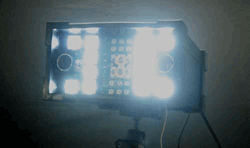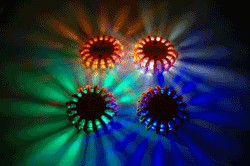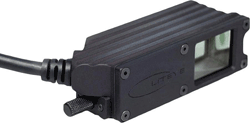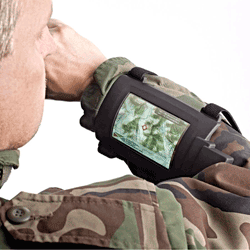Military applications are introducing energy-efficient solid-state lighting systems and equipment to the battlefield, emphasizing mobility, ruggedness, and adaptability
MICHAEL J. KAWA
From mobile command centers and field hospitals to communication hubs and personnel quarters, solid-state lighting (SSL) systems are being adopted for use in a variety of free-standing field shelters used in forward military operating theaters.
Shelter lighting
LED-based systems are rapidly replacing currently deployed incandescent and fluorescent lighting systems, which are high maintenance and very inefficient. By using leading-edge LEDs with high efficiencies and advanced thermal management design, these systems are producing superior, high-intensity lighting that consumes much less power and offers greater reliability. This reduces daily field operational costs and allows unused energy to be applied to other more critical operations.
LED lighting fixtures contain multiple high-powered LEDs to provide a uniform, high-quality output light for optimum illumination. They are inherently slim and lightweight, with a modular design, which makes them very adaptable to a variety of shelter shapes and sizes. Fixtures can be easily integrated into new lighting system designs or retrofitted into existing configurations using either ac or dc power distribution. Their small form factor and atypical flush ceiling and wall mounts provide extra clearance, which is important in tight=fitting shelters. Multiple fixtures can also be daisy-chained to provide appropriate coverage in improvised settings.

The OXLED military shelter light from Oxley Group provides three lighting modes in a single fixture: normal, emergency light, and blackout.
Units are extremely durable with rated lifetimes in excess of 75,000 hours. Their maintenance-free operation eliminates the need to store and transport fragile replacement bulbs and fixtures common with conventional systems easing the logistical needs during field operations. Advanced systems are being powered by solar panels so that they can be self-sustaining.
LED lighting systems also provide an extra measure of safety in the field with their inherent stealth operation. The fixtures do not emit audible noise, and they can be run on battery power, which eliminates noise from unneeded diesel generators that could draw attention to location. LED lights also provide cool operation since they do not radiate any forward heat, preventing fire hazards and virtually eliminating thermal and infrared (IR) signatures which can be spotted with night vision equipment.
While LED systems provide high-quality white light during normal operations, they also can provide low-power emergency lighting and selectable monochrome, colored lighting used in military “blackout” conditions. Each fixture can be instantly switch between desired lighting outputs with intensity-controlled arrays of different colored LEDs. This eliminates the need for multiple fixtures or manually adjusted filters, which can complicate traditional lighting systems.
Portable lighting
Portable LED-based lighting units are compact and lightweight allowing for easy transport and rapid deployment to remote locations during night time operations. They are self-contained systems used in a variety of applications such as emergency lighting, roadside checkpoints, general security, and maintenance operations. Their low power consumption allows for extended battery-powered operation, making them completely self sustaining and mobile.
Systems typically contain a light head populated with high-powered LED arrays and optics, which produces a controlled high-intensity light field for local or wide area illumination. They can be used for standalone operation or in tandem with other units to create perimeter lighting Additional light heads and adjustable height mounting on differently sized support stands can be used to increase total light output and coverage area.

The BrightEye Portable illumination system from Cyberlux can provide visible or covert illumination at over 1,000 ft.
Leading edge systems integrate IR LEDs into the light head arrays to allow for covert nighttime lighting. IR wavelengths are invisible to the naked eye but provide illumination in darkness when used with night vision goggles (NVG). This allows military personnel and monitoring cameras (with IR sensing) to see in the dark for night time surveillance, enabling local threat detection and full area protection. IR illumination also allows personnel to safely perform maintenance and work functions under the cover of darkness, allowing full 24/7 operation.
Field equipment
SSL has been integrated into a variety of standard field equipment for use by ground troops to provide localized illumination and signaling. These include handheld devices such as flashlights and spotlights in addition to compact lighting modules, which can be mounted to wearable headsets, hand attachments, or equipped weapons. Units are battery powered, typically using a single high-output LED or multichip LED module to provide a narrow beam of intense visible or IR light.
LEDs are also being used in tactical lighting beacons, which are employed in a variety of night time signaling applications requiring high detection and visibility. Situational uses include emergency signaling, warning marker and location tag for personnel or item recovery. Multiple units can also be used jointly for route marking or to establish perimeters for areas such as drop zones or improvised landing sites for helicopters.

The PowerFlare PF-200 from PowerFlare Corporation emits 360° of high-intensity light that can be seen up to 10 miles away.
These compact devices use high-output LED arrays to emit a 360 field of high-intensity light which can be seen for several miles. Units are designed to project a steady white light, a monochrome color or an IR wavelength for covert operations. Advanced units also provide selectable flashing patterns (including S.O.S.) for specific situational use.
SSL beacons were designed as a safe alternative to single use incendiary flares which can be a fire hazard and difficult to store due to safety concerns. LED units are reusable and have a rugged design which allows for safe operation in almost any environment. They are also battery powered and can operate for several days on a single charge.
Field displays using OLEDs
Organic light-emitting diode (OLED) displays are taking the lead in providing ground troops with instant access to mission-critical information and specialized imaging in the field. They are being used in small screen micro displays in a variety of near-to-eye military applications to provide tactical awareness, thermal imaging and night vision.
Display units are mounted on the head or helmet, allowing for complete hands-free operation. The viewing head integrates the micro display with magnifying optics to provide a virtual image comparable to a large screen monitor. The images are bright and rapid response which reduces eye fatigue during extended use. Transparent OLED architecture also allows simultaneous see-through vision through the eye piece providing unimpeded forward viewing.
OLED displays have an inherently small form factor, enabling easy integration into a number of portable viewer configurations. They also emit their own light and do not need backlighting like LCD units. This dramatically reduces their power consumption, allowing the battery operated displays to remain in the field longer for critical uninterrupted operation.

The LE-750 OLED micro display from Liteye Systems.
A developing OLED technology currently being field tested by the military is a flexible display which is produced by new manufacturing techniques that allow OLED displays to be applied to flexible substrates such as plastic or metallic foil.
The device is being used as a portable communication interface which can be comfortably worn around a soldiers' wrist or forearm for easy access and use. They are thin and lightweight with a rugged, fully functional color display that can be used for day or night operation.
Units are designed to enhance the situational awareness of soldiers in the field by providing them with instant wireless access to tactical information. This can include useful data such as live video feeds from aerial vehicles showing the surrounding area, active reconnaissance maps with GPS positioning and direct operational updates from command centers.
The interface also improves the mobility of forces in the field because of their reduced weight and power requirements. Cumbersome communication gear and extra batteries would no longer need to be carried.

A wrist-mounted flexible OLED display from Universal Display Corporation provides live tactical information to field troops.
Other potential devices that can use flexible OLED technology include small rolled up displays that can be carried in pen-sized tubes. These displays can be rolled out and viewed when needed and then rolled back up and conveniently stored in a pocket. OLED films also can be configured as a flexible lighting panel that could be used to provide wearable lighting. Panels could be embedded into clothing or equipment, reducing the need to carry external lighting devices. ■
Advertisement
Learn more about Electronic Products Magazine





